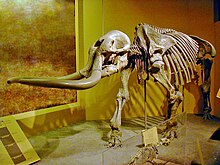Stegomastodon
| Stegomastodon | |
|---|---|

| |
| S. mirificus fossil at the Smithsonian Natural History Museum | |
| Scientific classification | |
| Domain: | Eukaryota |
| Kingdom: | Animalia |
| Phylum: | Chordata |
| Class: | Mammalia |
| Order: | Proboscidea |
| Family: | †Gomphotheriidae |
| Genus: | †Stegomastodon Pohlig, 1912 |
| Species | |
| |
| Synonyms | |
| |
Stegomastodon ('roof breast tooth') is an extinct genus of gomphotheres. It ranged throughout North America from the Pliocene (early Blancan ~4 Ma), to the Early Pleistocene (early Irvingtonian, ~1.2 Ma). The former South American species have been synonymized with Notiomastodon platensis.
Description
[edit]
Stegomastodon mirificus is known from NMNH 10707, a roughly 30-year-old male, of which most of the skeleton has been found. Alive, it stood about 2.6 m (8.5 ft) tall, with a weight around 4.7 tonnes (4.6 long tons; 5.2 short tons).[1] Unlike more primitive gomphotheres like Gomphotherium, it lacked lower tusks and had a shortened lower jaw. The upper tusks curved upward and were about 3.5 m (11.5 ft) long, and lacked enamel bands. The tall head and robust lower jaw suggest a strong vertical bite. Stegomastodon's third molars molars had at least 5 lophs (ridge-like structures), greater than previous gomphotheres. The strong bite and increased tooth complexity are suggested to be adaptations to a grazing diet.[2]
Origin and evolution
[edit]Stegomastodon is suggested to have ultimately originated from New World populations of Gomphotherium, possibly via the intermediate genus Rhynchotherium. [3] The earliest species of the genus appeared during the Pliocene (Blancan) around 3-4 million years ago. During the early Irvingtonian, around 1.2 million years ago, Stegomastodon became extinct, which is suggested to be due to competition with the recently arrived mammoths, which were more efficient grazers.[3] Originally, some specimens from Jalisco, Mexico were estimated to date to 28,000 years Before Present,[4] but this age was rejected in 2011 by Spencer G. Lucas et. al, who stated that the date was far too young to be viable and that it actually dates to the Blancan.[2]

Taxonomy
[edit]
The number of species within the genus has varied between S. mirificus being the only valid species, to Osborn's seven species of “ascending mutations” (S. primitivus, S. successor, S. mirificus, S. chapmani, S. texanus, S. arizonae and S. aftoniae) Lucas et al., 2013 accepted three overlapping chronospecies: S. primitivus, S. mirificus S. aftoniae.[5] The South American Stegomastodon fossils have been reassigned to Notiomastodon by the majority of recent authors.[6][7][3] Stegomastodon and Notiomastodon differ in numerous characters, including of the skull and limbs.[3] Revised taxonomy of Stegomastodon and other trilophodont gomphotheres according to Mothé et al., 2017:[8]
†Gomphotheriidae (Gomphotheres)
|
| ||||||||||||||||||||||||
References
[edit]- ^ Larramendi, A. (2016). "Shoulder height, body mass and shape of proboscideans" (PDF). Acta Palaeontologica Polonica. 61. doi:10.4202/app.00136.2014. S2CID 2092950.
- ^ a b Lucas, Spencer G.; Aguilar, Ricardo H.; Speilmann, Justin A. (2011). "Stegomastodon (Mammalia, Proboscidea) from the Pliocene of Jalisco, Mexico and the species-level taxonomy of Stegomastodon". New Mexico Museum of Natural History and Science Bulletin. 53: 517–553.
- ^ a b c d Spencer LG 2022. The last North American gomphotheres. N Mex Mus Nat Hist Sci. 88:45–58.
- ^ Alberdi, María Teresa; Juárez-Woo, Javier; Polaco, Oscar J.; Arroyo-Cabrales, Joaquín (2009-02-01). "Description of the most complete skeleton of Stegomastodon (Mammalia, Gomphotheriidae) recorded for the Mexican Late Pleistocene". Neues Jahrbuch für Geologie und Paläontologie, Abhandlungen. 251 (2): 239–255. doi:10.1127/0077-7749/2009/0251-0239.
- ^ Lucas, Spencer G. Taxonomy and evolution of the Plio-Pleistocene proboscidean Stegomastodon in North America. OCLC 798103439.
- ^ Mothé, Dimila; Ferretti, Marco P.; Avilla, Leonardo S. (June 2019). "Running Over the Same Old Ground: Stegomastodon Never Roamed South America". Journal of Mammalian Evolution. 26 (2): 165–177. doi:10.1007/s10914-017-9392-y. ISSN 1064-7554.
- ^ Alberdi, María T.; Prado, José L. (2022-08-03). "Diversity of the fossil gomphotheres from South America". Historical Biology. 34 (8): 1685–1691. Bibcode:2022HBio...34.1685A. doi:10.1080/08912963.2022.2067754. hdl:10261/271195. ISSN 0891-2963.
- ^ Mothé, Dimila; dos Santos Avilla, Leonardo; Asevedo, Lidiane; Borges-Silva, Leon; Rosas, Mariane; Labarca-Encina, Rafael; Souberlich, Ricardo; Soibelzon, Esteban; Roman-Carrion, José Luis; Ríos, Sergio D.; Rincon, Ascanio D.; de Oliveira, Gina Cardoso; Lopes, Renato Pereira (2 July 2017). "Sixty years after 'The mastodonts of Brazil': The state of the art of South American proboscideans (Proboscidea, Gomphotheriidae)". Quaternary International. 443: 52–64. Bibcode:2017QuInt.443...52M. doi:10.1016/j.quaint.2016.08.028. hdl:11336/48585.



